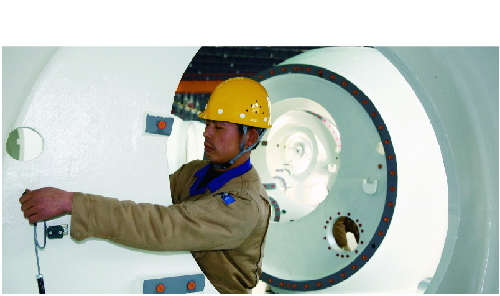|
 |
|
ENERGIZED: A worker puts finishing touch to a wind turbine near Shanghai (COURTESY OF SINOVEL) |
Developing clean energy, especially wind power, occupies a prominent position in China's 12th Five-Year Plan, the country's development guideline for the next five years starting 2011. During its 11th Five-Year Plan period from 2006-10, China's wind power industry has already moved from trailing the pack to being a world leader.
"[The wind power industry has] no carbon emission, no water pollution, no non-renewable resource consumption and China has great market demands for electricity. More importantly, we have support from the state. All these greatly contributed to China's rapid development of the wind power industry," Tao Gang, Senior Vice President of Sinovel Wind Group Co. Ltd., told ChinAfrica.
Statistics show that China ranks the world No.1 in terms of wind power installed capacity. According to Chinese Renewable Energy Industries Association (CREIA), by the end of 2010 China's accumulative installed capacity of wind power reached 41.83 million kw, exceeding that of the United States.
In 2010 alone, newly added wind power installed capacity hit 16 million kw, more than the combined amount of Europe (9.9 million kw) and the United States (5 million kw).
"Against the backdrop of rapid economic growth and great increase in power demand, China's wind power industry has maintained rapid growth in recent years, which plays an irreplaceable role in the country's energy diversification, environmental protection and energy saving and emission reduction," said Li Junfeng, Secretary General of CREIA in an interview with www.dt360.com, a website promoting low-carbon life in China.
According to Li, China's total wind power installed capacity of 41.83 million kw means annually reducing 31.29 million tons of coal usage, which helps cut down more than 90 million tons of carbon dioxide emission, 33,000 tons of suspended particulate matters, 64,000 tons of sulfur dioxide and 60,000 tons of nitrogen oxides.
Catch up
Before 2005, China's wind power industry lagged far behind that in European countries and the United States, and overseas wind turbine brands took a major share of the Chinese market. More than two thirds of wind farms in China were using foreign turbines.
In addition, according to Tao, all the turbines in China then were of low-level technology and were actually abandoned models from Europe and the United States. "When the United States and European countries were using wind turbines with mw-level capacity, China was using products with the capacity of several hundred kw, [which had been] eliminated from the European and American markets," said Tao. "This greatly increased the cost of wind power generation and restrained wind power development [in China]."
In October 2004, Sinovel introduced the world mainstream 1.5-mw wind turbine model into China, hoping to narrow the gap in wind power development between China and developed countries. But soon Tao found that European technology was not applicable to China's situation. "The wind and climate situations here are different from those of Europe and the United States," said Tao. "We need to develop our own products that can stand tougher weather conditions such as typhoons and extreme cold."
|